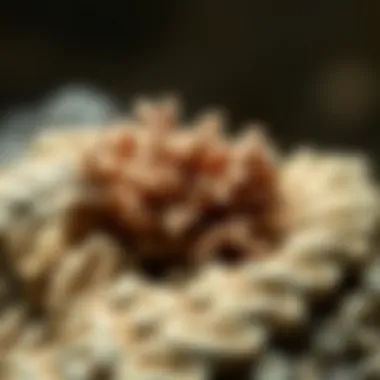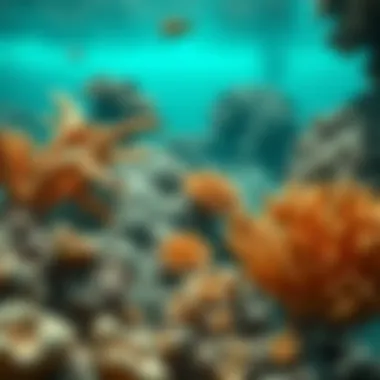Exploring Fossilized Coral: Nature's Ancient Wonders


Intro
Fossilized coral is more than a significant geological artifact; it’s a glimpse into the ancient oceans that once thrived with life. Acting as a time capsule, it holds secrets of environmental changes over millennia, offering insight into how marine ecosystems have evolved and adapted over time. As such, for enthusiasts and collectors alike, fossilized coral presents an opportunity to not only appreciate its aesthetic beauty but also to engage with a crucial piece of our natural history.
The journey into understanding fossilized coral begins with its biological roots. Coral is a living organism, part of a larger marine community, primarily composed of tiny polyps. These creatures work collaboratively, forming vast reefs that host a plethora of marine species. However, fossilization transforms these living communities into tangible history. Over eons, conditions in the ocean can lead to the remarkable preservation of coral, allowing us to study forms that lived millions of years ago.
In this guide, we will thoroughly explore various aspects of fossilized coral. We aim to shed light on the different species and types of coral that can be found as fossils, methods of identification, and the nuances of collection practices. Excavating the relationship between fossilized coral and environmental change, this article will exemplify the relevance of these ancient marvels in understanding our planet’s present and future.
Before diving deeper into the specifics, we will highlight a collectible that deserves special attention this month.
Intro to Fossilized Coral
Fossilized coral stands as a testament to the enduring nature of Earth's history, encapsulating stories from prehistoric seas within its hardened structures. It's more than mere rocks; it's a glimpse into ancient ecosystems that once thrived under the waves. Understanding fossilized coral is crucial for rock and fossil collectors, geologists, and paleontologists alike. Recognizing these organisms not only enriches one’s collection, but also provides insights into past environments and biological evolution.
When we think of coral today, the vibrant reefs come to mind, bustling with life and color. However, fossilized coral opens a portal to a time when the world was drastically different, encompassing various forms and habitats that no longer exist.
What is Fossilized Coral?
Fossilized coral refers to coral that has undergone a transformation from living tissue into rock-like structures over millions of years. This transformation generally occurs through a process called mineralization, where minerals seep into the coral's skeletal framework and replace its organic material. The result is often a stunning display of intricately patterned fossils, each serving as a natural archive of the environmental conditions of its time.
The journey from a living coral to a fossil is not just a biological process; it involves a myriad of geological factors including pressure, heat, and the surrounding sediment. The most common form of fossilized coral is the type created from stony corals, which have skeletons made primarily of calcium carbonate. These features make them particularly valuable to collectors, as they display a rich variety of colors and textures.
Differentiating fossilized corals from other sedimentary rocks can be tricky. Observers should look for the characteristic corallite structures, which are small holes or cups where the living polyps resided. This distinctive morphology not only aids in identification but also tells a story about the living conditions of the coral during its existence.
The Biological Background of Coral
Corals belong to the phylum Cnidaria and are related to jellyfish and sea anemones. They thrive in warm, shallow ocean waters and typically live in vast colonies made up of individual polyps. These tiny, flower-like creatures feed on microscopic plankton and algae, engaging in a symbiotic relationship with zooxanthellae, capable of photosynthesis. This partnership is crucial, as it provides energy to the corals, contributing to their growth and vitality.
Coral reefs, composed of myriad species, represent some of Earth's most diverse ecosystems. They play a vital role in marine biodiversity, serving as habitats for countless marine organisms, from fish to mollusks.
During periods of environmental stress or change, corals can experience bleaching, where they expel their symbiotic algae, leading to their eventual decline or death. Understanding the biological mechanisms of coral growth and survival helps to grasp their fossilized forms better, revealing a window into their ecological past.
Fossilized corals are not only stunning works of nature but also essential indicators of historical climatic patterns. Their structures become records of the oceanic conditions under which they flourished, offering insight into ocean acidity, temperature fluctuations, and biodiversity during specific geological epochs.
In summary, delving into fossilized coral grants us a special look into ancient worlds, crucial for the education of collectors and enthusiasts alike, illuminating how life adapted—and often thrived—under ever-changing environmental conditions.
The Process of Fossilization
Understanding the process of fossilization is paramount in grasping how fossilized coral forms and what that implies about our planet's past environments. This intricate activity not only sheds light on the life forms that once thrived in our oceans but also informs us about the climatic conditions and geological events that have shaped our world over millions of years. Fossilization transforms once-living organisms into records of Earth's ancient ecosystems, making it a cornerstone of both paleontology and geology.
Understanding Fossilization
Fossilization is not simply about the passing of time; it's a complex interplay of biological, chemical, and physical processes. At its core, fossilization usually begins when an organism dies and becomes buried under sediment. If the conditions are right, rather than decaying and returning to the environment, the organism becomes encased in dead material. Over eons, specific minerals seep in, replacing organic material, effectively petrifying it into stone. This process may vary from simple permineralization—where minerals fill the spaces within organic structures—to complete replacement, where the original material is replaced wholly by minerals, like silica.
There are several key facets to consider:
- Time: The more time that elapses, the greater the potential for fossilization.
- Burial Depth: Being buried under layers of sediment protects the remains from decay and erosion.
- Mineral Presence: The types of minerals available in the sediment play a vital role in determining how well a fossil is preserved.
A substantial aspect of fossilization is its disparity across different environments. Not all dead corals will fossilize, as some may be left exposed to open air or scavengers. For instance, coral species living in shallow waters have a higher chance due to rapid sediment deposition compared to those in deeper regions.
Conditions Favoring Fossilization
The conditions that promote fossilization are numerous and varied, playing an instrumental role in shaping the eventual fossils we uncover. It is clear that fossilization is more likely to occur under specific circumstances:


- Rapid Burial: Quick coverage by sediment shields the remains from elements and scavengers.
- Low Oxygen Environments: Areas with limited oxygen slow down decay, creating an ideal scenario for preservation.
- Calcareous Environments: In marine conditions, calcareous material can enhance the preservation of corals since they often have calcium carbonate in their structure.
"The environment in which an organism resides greatly influences its likelihood of being fossilized, just as much as the organism's characteristics itself."
- Water Chemistry: The chemistry of the water surrounding a coral colony impacts mineral deposition. Water loaded with bicarbonate ions can lead to better fossil formation.
- Temperature Stability: Extreme temperature fluctuations can lead to rapid decomposition. Steadier temperatures during burial, generally in sediment bed, allow fossils to form more reliably.
Awareness of these factors allows collectors and students alike to appreciate the unique stories that each fossil can tell. They are, in essence, time capsules that echo a long-lost world, linking us to the intricate tapestry of life that has come before us. For anyone interested in rock and fossil collecting, understanding these processes enriches the pursuit and contextualizes the specimens found in the field.
Types of Fossilized Coral
Understanding the various types of fossilized coral is essential for appreciating not just their beauty, but the information they hold regarding ancient marine ecosystems. These corals provide a window into times long past, revealing details about environmental conditions, species evolution, and even climate shifts. For collectors and enthusiasts, identifying these unique varieties can enhance their collections and deepen their comprehension of paleontological histories.
Common Varieties of Fossilized Coral
When it comes to fossilized coral, several notable types stand out, each showcasing a unique facet of the natural world. Here are a few common varieties:
- Agaricia: This type is known for its flat, plate-like structures that resemble a small pancake stack. It can give insights into the depths of ancient coral reefs.
- Favosites: This coral has a honeycomb appearance, with multiple small, tubular structures. Fossils of Favosites can often be found in marine rocks, hinting at shallow, warm waters alive with diversity.
- Solenopora: Distinguished by its intricate, branching patterns, Solenopora fossils often appear in geologic formations where biodiversity was high. This type indicates a complex ecosystem that thrived millions of years ago.
- Montastraea: Commonly called brain coral, it gets its name from its convoluted surface. Fossils found in this variety can indicate historical conditions favorable to coral growth in warmer climates.
Each variety contributes to our understanding of the sedimentary record and serves as an indicator of the environmental changes that have occurred over eons.
Identifying Fossilized Coral Species
When venturing into the world of fossilized coral, the ability to accurately identify species can be both rewarding and challenging. Here are some basic pointers to consider:
- Examine the Texture: Many corals have specific surface patterns. For instance, Montastraea has distinctive ridges, while Favosites is more uniform and honeycombed.
- Check for Coloration: Fossils can range in color depending on their mineral content. Look closely; some species retain vivid hues that can make identification easier.
- Study the Structure: Observing the overall formation can help. If a specimen shows branching structures or plate-like forms, it might guide you toward a conclusion about its species.
- Use Reference Material: Guides or online databases, like those found at Britannica, can offer insight. Many paleontology sites like Wikipedia provide specific details on coral species.
Fossilized Coral and Its Significance
In the grand tapestry of Earth's history, fossilized coral stands as a testament to life's resilience and adaptability. These ancient structures, composed of calcium carbonate and often exhibiting intricate patterns, serve as significant markers for understanding past marine environments and ecological shifts. Their significance stretches beyond mere aesthetics; they unlock stories about climate variations, biodiversity, and environmental health through the epochs.
Ecosystem Indicators Through Time
Fossilized coral provides a vital window into prehistoric ecosystems, functioning almost like nature’s own archive. When we analyze the arrangement and composition of coral fossils, we glean insights into the habitats they thrived in. For instance, higher concentrations of certain coral species in fossil records often indicate warmer, more tropical seas, while areas with a mix of different types suggest a more diverse ecosystem. This pattern holds an essential clue about historical biodiversity, revealing how ancient marine life linked intricately to coral formations.
- Coral Reefs as Habitats: Fossil corals housed numerous species, from fish to invertebrates. They acted not only as shelters but also as feeding grounds, demonstrating interconnectedness in the marine food webs of yesteryears.
- Indicators of Water Quality: The type and health of coral present in fossil records can signal information about ancient water quality. Examples include the proliferation of particular coral varieties, which may suggest periods of nutrient-rich waters versus more stressed environments.
As a consequence of their sensitivity to environmental conditions, changes in fossilized coral populations can hint at the ecological shifts that took place over millennia. This correlation helps scientists predict how current coral species might respond to ongoing climate changes, making them critical study subjects in conservation efforts.
Paleoclimatic Research and Its Implications
The study of fossilized coral extends into the realm of paleoclimatology, providing insights into Earth’s climatic history. Since coral growth is greatly influenced by temperature, salinity, and atmospheric CO2 levels, these ancient organisms serve as excellent indicators of past climate conditions. Analyzing the composition of coral fossils can yield detailed climatic narratives over millions of years, allowing researchers to identify patterns of warming and cooling periods.
- Temperature Reconstruction: By examining isotopic ratios in the skeletons of fossilized coral, scientists can infer past sea surface temperatures with remarkable precision. This data helps align coral biochronology with historical climate events like ice ages and warm periods.
- Climate Change Models: The insights drawn from corals inform climate change models, aiding in predictions of future shifts. Understanding historical coral responses to climate variations arms researchers with knowledge about potential marine futures amid anthropogenic influences.
"Coral reefs are more than just beautiful underwater formations; they are crucial to understanding our planet's climate system."
Ultimately, the significance of fossilized coral lies not only in their aesthetic contributions to geology but also in their power to communicate historical climate fluctuations and ecological transformations. For rock and fossil collectors, these ancient remains are not simply relics; they embody rich narratives of life, survival, and the Earth's dynamic climate history. By studying these coral fossils, we better appreciate the complexities of our ecosystems and the urgent need to protect our living coral reefs today.
Collecting Fossilized Coral
Collecting fossilized coral carries a unique blend of adventure and education. It serves not just as a hobby for enthusiasts but as a vital link to our planet's history. Fossilized coral, which is essentially the ancient remains of coral reefs, provides insights into past marine ecosystems and climatic conditions. For collectors, each piece stands as a testament to geological processes, affording a tangible connection to Earth’s distant past.
Fossilized coral is often found in various locations, ranging from coastal regions to inland areas where ancient seas once thrived. As collectors embark on their journey, it is crucial to appreciate both the responsibility and thrill woven into the practice. This not only heightens the experience but encourages respect for the natural world and its history.
Best Practices for Collecting


When it comes to gathering fossilized coral, there are several best practices to keep in mind that enhance both the experience and the integrity of the finds:
- Research Your Locations: Before setting out, familiarize yourself with local geology. Some areas have laws governing the collection of fossils, so understanding what’s allowed will save you headaches later.
- Bring Proper Tools: Equip yourself with tools such as a rock hammer, chisel, visors, sturdy gloves, and a brush for cleaning. These will help protect both you and the fossil.
- Document Your Finds: Keeping a log of where and when you collected each piece is invaluable. This information gives context and can help with future research or queries.
- Practice Safe and Respectful Collecting: Whether in a designated fossil park or private land, always seek permission and ensure you leave no trace behind.
- Keep It Ethical: Avoid over-collecting. Leave some specimens for others and for the ongoing study of these important pieces of history.
Collecting fossilized coral can be a rewarding endeavor that not only enriches personal collections but can also deepen one's understanding of ancient marine ecosystems.
Legal and Ethical Considerations
Engaging in the collection of fossilized coral comes with a set of legal and ethical responsibilities. It's essential to navigate these waters carefully to avoid potential penalties or unintended harm to ecosystems:
- Know the Law: Many countries and states have specific laws that protect fossils, especially those on public land. Consult local regulations or resources, such as .gov or .edu sites, to clarify what is permitted.
- Public Lands: When collecting on public lands, ensure to follow established guidelines. Organizations like the Bureau of Land Management provide resources on what can and cannot be collected.
- Private Property: Always secure permission from landowners. Trespassing not only jeopardizes future collecting opportunities but may lead to legal repercussions.
"Ethics in collecting means being aware that these pieces are not merely objects, but remnants of ecosystems that deserve respect and care."
- Environmental Impact: Consider the ecological ramifications of fossil collection. Excessive excavation can disrupt local habitats and diminish biodiversity. Aim to minimize your impact by collecting responsibly and sustainably.
- Collaboration with Researchers: If you have a noteworthy find, consider reaching out to local universities or museums. Sharing your discoveries can contribute to valuable research and education.
For further guidance on legalities and ethical collection practices, you can explore relevant resources on sites like Wikipedia, Britannica, or Reddit.
Caring for Fossilized Coral
Preserving fossilized coral holds great significance, especially for enthusiasts and collectors. These ancient treasures offer a glimpse into Earth’s geological history. Taking care of them is not just about maintaining their aesthetic value; it's about ensuring their scientific integrity for future generations. When one invests time in understanding proper care methods, the benefits are manifold. Not only can the condition of these fossils be maintained, but their historical narrative can also be preserved for educational purposes. This section will dive into two crucial aspects of caring for fossilized coral: cleaning and maintenance techniques, along with best practices for display and preservation.
Cleaning and Maintenance Techniques
Cleaning fossilized coral is essential to prevent the accumulation of dirt and grime which can obscure its features. However, care should be taken to avoid harsh chemicals or abrasive materials that might scratch the surface. Here are some recommended techniques:
- Gentle brushing: Use a soft-bristled brush to remove loose dirt. An old toothbrush can be quite handy, making sure that it's dry to avoid water residue.
- Mild soap solution: If deeper cleaning is required, a mix of water and a few drops of mild soap can be effective. Dip a soft cloth in the solution, then carefully rub the coral. Make sure to follow with a damp cloth to remove any soap residue.
- Drying: After cleaning, let the coral dry naturally away from direct sunlight, as intense heat can damage its structure.
A gentle touch can make all the difference when caring for such ancient relics.
By being mindful and attentive during the cleaning process, collectors can help preserve the intricate structures of the coral. Routine maintenance checks will also go a long way; this means looking out for any signs of cracks or discoloration and addressing them promptly.
Display and Preservation Tips
Displaying fossilized coral not only enhances its appreciation but also plays a pivotal role in its preservation. Here’s how to do it effectively:
- Use UV-filtering glass: When framing or displaying coral, consider using UV-filtering glass. This helps protect the fossils from harmful light that can fade or degrade their structure over time.
- Stable environment: Keep fossilized coral in a stable environment, free from fluctuations in temperature and humidity. Ideally, a climate-controlled room is best.
- Avoid damp places: Moisture can lead to mildew development. Displaying coral in a dry location not only looks appealing but ensures longevity.
- Secure footing: When displaying, ensure that the fossil is secured. Use a sturdy stand or display case where it won't easily topple over. This also minimizes the risk of accidental damage.
Maintaining fossilized coral isn’t just a responsibility; it’s an enriching process that deepens one’s connection to the natural world.
The Role of Fossilized Coral in Education
Fossilized coral serves as a gateway to understanding not just ancient marine ecosystems but also broader geological and environmental concepts. In educational settings, this unique material allows students of all ages to dive into the rich history of our planet, offering tangible evidence of life forms that thrived millions of years ago. By integrating fossilized coral into curricula, educators can highlight key lessons about evolution, biodiversity, and climate change.
When discussing the significance of fossilized coral in formal education, it’s essential to consider the multifaceted benefits it can provide. Firstly, it encapsulates a cross-disciplinary approach, bridging biology, geology, and even art forms, as these ancient specimens often find their way into creative projects. Moreover, fossilized coral can foster critical thinking and investigative skills, motivating students to ask questions, conduct research, and engage in discussions about the future of coral reefs and environmental conservation.
Education is about igniting curiosity, and fossilized coral can certainly act as that spark. For example, examining distinct fossilized textures and formations enables students to draw parallels between these ancient organisms and modern corals, reinforcing lessons on resilience and adaptation. When students see how ecosystems evolve over time, it may encourage them to think critically about their actions in the present.
"Fossilized coral brings ancient ecosystems to life, connecting past events to today's environmental challenges."
Integrating Fossilized Coral in Curriculum
Incorporating fossilized coral into educational frameworks can be a seamless process with the right approaches. Here are some ways to effectively do this:


- Field Studies: Organizing field trips to coastal locations or museums housing fossil collections can provide firsthand experiences. Students can collect their own samples under supervision, understanding the process of how coral fossils are formed and the rich history they represent.
- Laboratory Activities: Conducting labs where students analyze microfossils or create their own fossil replicas can deepen their understanding of paleontology. Learning how to identify key features in fossilized coral can help sharpen their analytical skills.
- Project-Based Learning: Students can develop projects around coral reefs, exploring both their historical significance and current threats. This method encourages collaboration and critical thinking, allowing students to present their findings through various mediums.
By weaving fossilized coral into different subjects, educators can not only make lessons more engaging but also demonstrate real-world applications of theoretical knowledge.
Encouraging Young Collectors
Fostering an interest in fossil collection among younger audiences has its merits, both for education and personal growth. Young collectors can gain valuable insights into geology, ecology, and even history as they unearth these age-old treasures. Here’s how to support budding fossil enthusiasts:
- Workshops: Hosting workshops on fossil identification and collection techniques can provide foundational skills for young enthusiasts. Such workshops can help ensure they understand the importance of ethical collecting practices that respect our natural heritage.
- Mentorship Programs: Pairing novice collectors with experienced mentors can enhance the learning experience. A mentor can share knowledge about identifying different coral types and discuss the importance of conservation.
- Online Communities: Encouraging young collectors to join forums or social media groups dedicated to fossil enthusiasts can create a supportive network. Engaging discussions and shared experiences can motivate them to continue their passion and expand their knowledge.
By instilling a sense of respect for nature and a thirst for learning, we can cultivate the next generation of scientists and conservationists who appreciate the intricate dance between nature and history.
For more details on fostering a love for paleontology among youth, consider exploring resources like National Park Service, Smithsonian Institution, or Paleontological Society.
Modern Environmental Relevance
The relevance of fossilized coral today resonates deeply within the scope of environmental science and sustainability. As we grapple with modern ecological quandaries, it becomes paramount to explore how these ancient wonders inform our understanding of current environmental changes. Fossilized coral offers a glimpse into historical ecosystems, which is instrumental in understanding marine responses to climate change and habitat shifts over millennia. By studying coral fossils, researchers can decipher past marine conditions and project their implications on contemporary coral reefs.
Coral Reefs and Climate Change
Coral reefs, often dubbed the rainforests of the ocean, are invaluable ecosystems that provide shelter, food, and stability for a plethora of marine life. Unfortunately, the impact of climate change poses an ever-present threat to these vibrant structures. The increasing ocean temperatures, driven by global warming, lead to coral bleaching — a phenomenon where stressed corals expel the symbiotic algae living within them. When coral reefs are devoid of these algae, their vibrant colors fade, making them more vulnerable to disease and mortality.
Fossilized coral serves as a historical record, making it possible to recognize patterns of resilience and decline across geological timescales. By correlating fossil records with present-day coral health, scientists can identify which species might withstand climate stresses. For instance, fossils from the past may showcase how particular coral types adapted to temperature spikes or significant ocean acidification events, providing a model for current reef recovery efforts.
Some key points regarding coral reefs and climate change include:
- Past Adaptation: Fossil records indicate that certain corals have survived climate fluctuations by developing adaptive traits.
- Carbonate Production: Coral reefs play a crucial role in carbon sequestration, affecting global carbon cycles.
- Ecosystem Services: Healthy reefs underpin coastal protection, fisheries, and tourism. Losses could deeply affect local economies and biodiversity.
Fossilized Indicators of Environmental Change
The study of fossilized coral functions as a vital tool in understanding how past environmental conditions influenced marine ecosystems. Each layer of fossilized coral encapsulates clues about temperature, salinity, and ocean chemistry. Analyzing these fossils enables scientists to reconstruct ancient marine environments, which can illuminate the trajectory of future changes.
Key indicators to note include:
- Isotope Analysis: By examining stable isotopes within coral fossils, researchers can determine historical sea surface temperatures and climate conditions.
- Extinction Rates: The fossil record indicates which coral species failed to adapt to changing conditions, offering insights into potential future extinctions.
- Holocene Transition: Studies of coral from the Holocene epoch inform scientists of significant climatic shifts and biological responses across various ecosystems.
By understanding how fossilized coral reflects environmental shifts, researchers can foster predictive models for modern coral reefs amid climate crisis. These investigations highlight an urgent need for conservation, showcasing the critical role of fossilized coral as both a historical narrative and a clarion call for present-day action.
Future Directions in Fossil Coral Research
The area of fossil coral research continues to evolve, driven by advancements in technology and a growing awareness of environmental issues. Understanding potential future directions in this field is crucial as they hold the key to not only furthering our knowledge of historical ecosystems but also addressing contemporary challenges related to marine conservation. Researchers are increasingly recognizing the importance of fossil records as they relate to climate change and biodiversity. Knowing how these ancient marine organisms responded to past climate fluctuations can inform how current coral reefs might adapt—or fail to adapt—to ongoing changes in their environments.
Technological Advances in Research
Technological ingenuity is paving the way for groundbreaking discoveries in fossil coral research. For instance, high-resolution imaging techniques allow scientists to analyze coral structures in ways that were previously unimaginable. These methods enable closer inspection of the microstructure of coral skeletons, shedding light on their growth patterns and responses to environmental changes.
Additionally, geochemical analyses are making significant waves. Researchers are using stable isotope studies to gain insight into past ocean temperatures and chemistry. By understanding the chemical signatures left in fossilized coral, we can trace the history of oceanic changes, which is vital for predicting future shifts.
The integration of machine learning and artificial intelligence into research methodologies can streamline data analysis and facilitate pattern recognition across large datasets. Such advances would not only enhance the accuracy of paleoclimatic reconstructions but also speed up the research process dramatically.
Global Initiatives in Fossil Conservation
Conservation efforts surrounding fossil coral are becoming more widespread, reflecting a collective understanding of their importance to our geological and biological heritage. A multitude of global initiatives target fossil conservation, aimed at protecting sensitive fossil sites from the threats of development and climate change.
Some key components of these initiatives include:
- Policy Advocacy: Many organizations are working tirelessly to influence policy regarding land use and fossil protection, ensuring that sensitive areas are preserved for future generations.
- Community Engagement: Strengthening community ties is crucial in local conservation efforts. Educating communities about the value of fossil corals fosters a sense of ownership and responsibility toward these natural wonders.
- Collaborative Research: Numerous international partnerships are being formed to share knowledge and resources, amplifying efforts in fossil coral studies and conservation.
"The path we choose today in conserving fossil corals will dictate the ecological landscape of our oceans tomorrow."
Undoubtedly, the road ahead in fossil coral research holds promising potential. As technology advances and global initiatives flourish, the understanding of both fossilized corals and their implications for today’s marine ecosystems can greatly improve. This is an opportunity to not only gather more data but also to cultivate an informed community that values and protects these ancient remnants of life.



